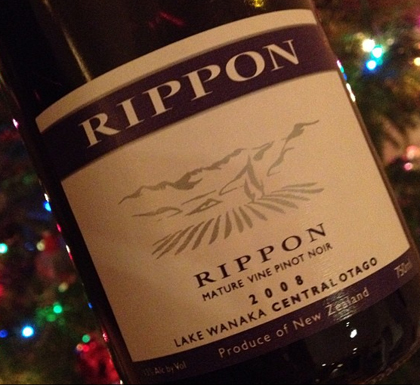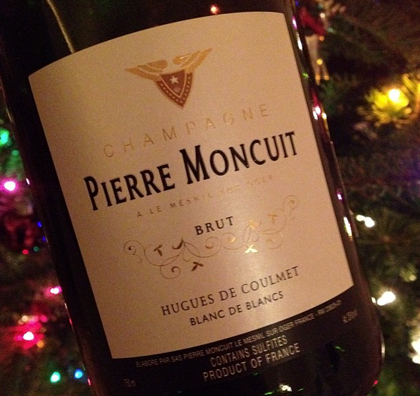Dr Vino's wine blog
wine talk that goes down easy
Vieilles vignes from Middle Earth
Here’s a wine that I enjoyed over the holidaze: Rippon, “mature vines,” pinot noir, 2008 from Central Otago(find this wine). It’s worth mentioning first and foremost because it is a tasty, succulent pinot, surprisingly, not an in-your-face fruity pinot. Instead, it’s got an alluring earthiness and minerality, a snap of acidity, all infused with gentle red fruits and a bit of savory spice. With a moderate alcohol (13% on the label), it’s a winner from Middle Earth.
The other thing worth flagging about the wine is the term “mature vines.” The vines, planted in 1986 – 1994 on the shores of Lake Wanaka, are among the oldest remaining on the estate. While “old vines” sometimes appears on labels, it is completely unregulated and seems both arbitrary and pretentious as well as occasionally misleading (one person’s “old” may be someone else’s young.) While “mature vines” is still somewhat arbitrary, it’s at least accurate and, imho, not pretentious.
A rarity for New Zealand–it’s closed with a cork, granted a “taint-free cork” (aka Diam).
Scotland to women: wine makes you look old and fat
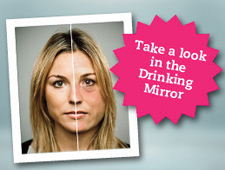 Health officials in Scotland have come up with a new weapon in their campaign against excessive drinking: an app that makes you look fat. And old.
Health officials in Scotland have come up with a new weapon in their campaign against excessive drinking: an app that makes you look fat. And old.
The app, called The Drinking Mirror, shows a projection of what the user may look like if they keep drinking at current (elevated) levels. The results are not pretty. But, seriously, who would use such an app other than people who had been drinking?!
Oddly, the app targets mostly women even though they have a lower incidence of excessive drinking. And the app translates alcohol units only as wine, not other alcoholic drinks. WWTJT? What would Thomas Jefferson think? He preached the virtues of wine as a drink of moderation compared to, say, whiskey. Of note: scotch doesn’t figure in the campaign from Scotland. Read more…
Merry, merry Moncuit
Best wishes to everyone for the holidays!
We uncorked a Pierre Moncuit, “Hugues de Coulmet” brut NV to kick things off. It’s always a terrific champagne that happens to be a great value. This importer’s page reveals that the blanc de blanc sees no time in wood but also has no reserve wine in the cuvée, each of which is a single (alas, unknown via the label) vintage. The house is located in Mesnil but the fruit for this wine comes from just outside of Mesnil in Sézanne. It’s really bright and fresh, with good fruit as well as yeasty complexity. I suppose it would be great with sushi, but we had it as an aperitif and it fit the bill perfectly. I bought it on sale for $32–should have loaded up on more to share with Santa and the reindeer (find this wine at retail).
Champagne Jacquesson
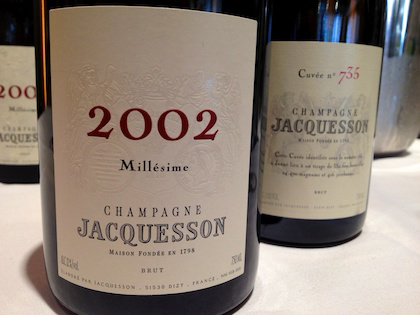
A pair standout champagnes I tasted this fall were from Jacquesson, a small house in Dizy run by the brothers Jean-Hervé and Laurent Chiquet (brothers of Gaston). Jacquesson has a number of interesting things going on as they drive toward distinction. First, they are making only one wine that is a blend of sites, their nonvintage “700” series cuvée. (No, this isn’t a BMW.) Each NV blend has a different base wine each year and thus gets a different number. The “735” that I tasted draws 72% of the wine from the 2007 vintage, with the remainder from reserve stocks. It has beautiful poise, a bready aroma balancing on a sprightly core of acidity.
Second, the 2002 is the end of the line for multi-site vintage wines at Jacquesson. From here on out, they will be doing only site-labeled vintage cuvées (there weren’t any of those at the walk-around tasting I attended), no multi-site vintage wines. As you might expect, given the vintage, the 2002 was serious stuff, with more depth and complexity than the sprightly “735,” but still tightly wound stoniness with many years ahead of it.
Third, the labels are terrific. The back label is possibly Read more…
Lapierre and Coudert: two superb 2011 Beaujolais
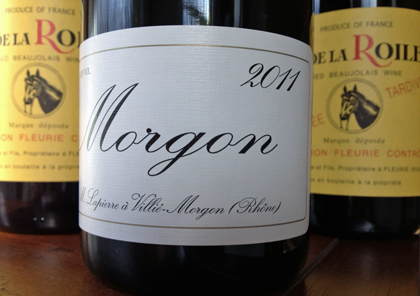
Beaujolais has had a string of great vintages–2009 was warm, which made for fuller wines (relatively speaking) while 2010 and 2011 have made some gorgeous, classic wines. Unfortunately, the run stopped with 2012, which was difficult.
So focus on the 2011s, now on the shelves. I picked up some Lapierre Morgon 2011 before Hurricane Sandy hit; after a week without power, it was a delight to pop a bottle with friends, lights blazing and heat pumping again. This was Mathieu Lapierre’s first full vintage making the wine and he maintains the light touch in the cellar that his father established. The wine has tremendous poise, delicacy and transparency, some fruit coming through, but also the stony minerality.
Similarly, the Clos de la Roilette wines of the Coudert family are also stunning in 2011. These serious Fleuries, especially the Cuvée Tardive, almost have more oomph than the Lapierre Morgan. All three of the wines have a lip-smacking appeal, that makes you want another glass, reach for some more food, and generally love life.
These are among the best in Beaujolais so it is amazing that they are also relative values at about $25. And the 2011 “regular” Roilette is about $20 and gorgeous. These are wines that I buy every year and one or the other always gets a place at our Thanksgiving table.
South African cabernet franc: Bruwer Raats #video
What’s the best red variety for South Africa? Bruwer Raats would vote for cabernet franc. Listen to him explain why in the above video.
His wine, made from 25-year-old, unirrigated vines and stylistically more St. Emilion than Saumur, is a strong example of cabernet franc with meaty, floral character with perky tannins. Unfortunately, Raats’ enthusiasm for the grape hasn’t been infectious: I only came across one other example of it as a varietal wine. But since I didn’t get to try the one from Buitenverwachting, this makes the Raats the best cabernet franc that I tasted from South Africa!
Raats also makes the Mvemve Raats de Compostella with Mzokhona Mvemve. A fuller-bodied wine than the straight cabernet franc, the 2009 manages to strike an alluring balance between fruit, acidity and tannin. And, true to his passion, it’s a quarter cabernet franc. Read more…
Broadcasting Baroque to the vines at DeMorgenzon
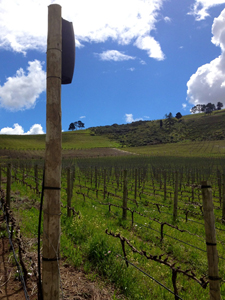 Kobe beef cows may be jealous: the vines and barrel room at De Morgenzon winery in Stellenbosch have Baroque broadcast 24 hours a day.
Kobe beef cows may be jealous: the vines and barrel room at De Morgenzon winery in Stellenbosch have Baroque broadcast 24 hours a day.
The DJ is Hylton Applebaum, who owns the property with his wife Wendy (Hylton also owns the Classic FM radio station in Johannesburg). Hylton says that the mix includes no music “that annoys people,” ruling out harpsichord, energetic violin solos or organ, which sounded funereal. Opera and all human voice were excluded from the track because they could be too jarring for the staff and neighbors. The staff that I spoke with say the music has a calming effect. Only certain blocks have been wired for sound, including a block of syrah behind the winery.
Hylton says the vineyard with the music shows slower growth than adjacent vineyards that have no music. “We are able to achieve phenolic ripeness with lower sugars,” he said as we stood among the vines.
I asked him if techno would speed up the growth. He said that some experiments in central Europe had shown a variation in tomatoes with the type of music played; jazz worked well but heavy metal killing the plants.
De Morgenzon’s “DMZ” line represents good value at about $15 in the US; the standout of the line is the crisp chardonnay, which has just a hint of early Mozart on the nose. Their top wine, a 100% chenin blanc, presented a serious side of chenin. But more on that in a future post. Read more…
A bun in the oven and wine in the glass
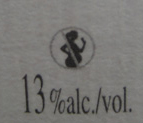 Picture this: a guy sitting around a table with three pregnant women having drinks. That was the scene recounted to me once by an internist about his wife, an obstetrician, and two of her OB/GYN colleagues while they attended a medical convention. He told me that the doctors considered drinking in moderation was safe. They just couldn’t really tell patients that because some would abuse it and, of course, liability concerns.
Picture this: a guy sitting around a table with three pregnant women having drinks. That was the scene recounted to me once by an internist about his wife, an obstetrician, and two of her OB/GYN colleagues while they attended a medical convention. He told me that the doctors considered drinking in moderation was safe. They just couldn’t really tell patients that because some would abuse it and, of course, liability concerns.
This perspective on drinking while pregnant got some recent validation. The researchers at Aarhus University in Denmark collected data from 1,600 pregnant women and their babies up to five years old. Their studies indicate that drinking one to eight (!) servings of alcohol a week during pregnancy, even in the early stages, showed no IQ differences in the children than group of mothers who abstained from alcohol. Even binge drinking didn’t have an impact, surprisingly. The babies from mothers who consumed over nine drinks a week showed lower attention spans.
Pregnancy is a tricky thing and many women would want to err on the side of caution; the Centers for Disease Control and Prevention, which partially funded the studies, still recommends that Americans abstain from alcohol during pregnancy. Even French wine labels now bear an image warning against drinking while pregnant. But I guess everything worked out okay for Rachel Weisz, who spoke out for moderate drinking during her pregnancy and sparked an uproar, especially now that she’s Mrs. Daniel Craig!
